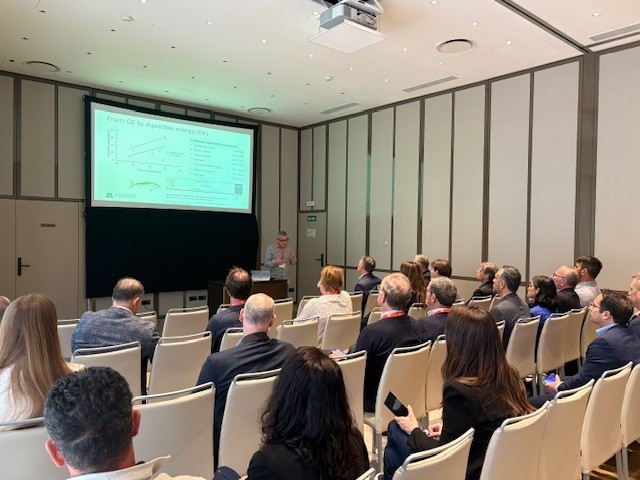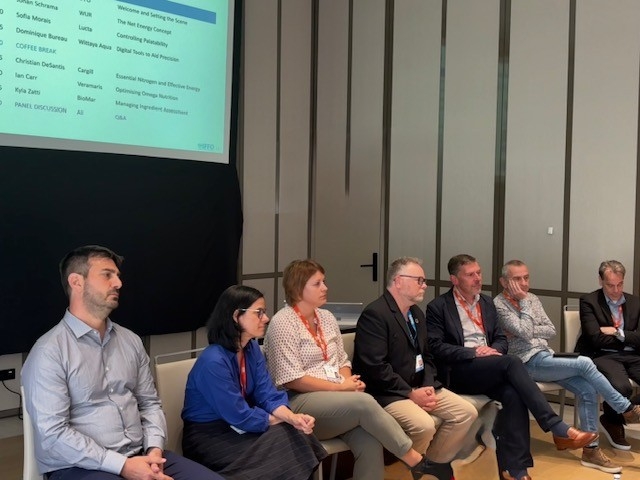This technical InFocus workshop, chaired by Brett Glencross, Technical Director at IFFO and held on 12 May 2025 on the sidelines of the IFFO Members Meeting in Madrid, explored the fast-developing area of precision nutrition in aquafeed, looking at the important role of palatability, formulation to net energy, omega-3 and amino acid demands, and the latest digital tools to design and assess feed formulations. The workshop featured seven technical experts: Brett Glencross, Technical Director at IFFO, Johan Schrama from Wageningen University & Research, Sofia Morais, from Lucta, Dominique Bureau, from Wittaya Aqua International, Christian DeSantis, from Cargill Aqua Nutrition, Ian Carr, from Veramaris and Kyla Zatti, from BioMar Group.
“Precision nutrition is providing an animal with the right nutrients at the right time and in the right amounts based on their current and emerging needs”, Brett Glencross started. “With precision nutrition, we will move beyond digestible nutrient demands into metabolizable and net demands”.

Formulating feeds in a precision nutrition era
From an aquaculture perspective, diet specifications are based on what animals need, their requirements. However, the formulation process is based on meeting those specifications through an understanding of the ingredients, while minimising any risks to using them. Ultimately, cost is the determining factor. Fundamentally, animals require nutrients and energy, not ingredients, but critically it is ingredients that supply those nutrients and energy. The use of nutritional models has been instrumental in consolidating our understanding of those nutritional requirements. While all animals have a need for about 40 dietary nutrients as part of a balanced diet, their requirements for those nutrients are constantly changing.
“Consumed macronutrients (protein, fat, carbohydrate, minerals) underpin growth and reproduction. Protein and carbohydrates can be used as an energy source and if given in excess can be stored as fat” Johan Schrama noted. Energy is needed for ATP (adenosine triphosphate) production. ATP is the main energy currency of the cell, and its synthesis requires an input of energy, typically from the breakdown of nutrients.
The net energy concept in aquaculture has led to the realisation of the actual energy available from different nutrients (protein, fat, starch) within various ingredients. Importantly, it has been noted that this is not consistent across some species. Some species like tilapia seem to use starch well, whereas others like snakehead not-so-much. In snakehead diet, for instance, wheat doesn’t contribute to the net energy system, as the fish appears unable to effectively use the energy from starch.
Aquaculture diversity
Aquaculture is diversity and different markets have different requirements. “In precision nutrition feed formulation, you need to define your objectives, then understand the animals requirements (define nutritional specifications), then understand the ingredients (characterise ingredient composition), before you can optimise feed formulations and production objectives. Then you manufacture the feeds and monitor results in the feed – a stage that is often forgotten” commented Dominique Bureau. For many species, the academic knowledge base was incomplete in the 2010s. It was observed that the nutritional requirements of the animals for various nutrients changes (usually decreases) as the animal grows. Feed given in excess of demands results in pollution and money wasted. The development of the IAFDD.com database covers estimates on requirements for 41 species (ASNS v10.0). “We use a factorial modelling approach to estimate requirements. Using this, we developed specific nutritional specifications. We are looking for feedback to understand whether the values we are recommending are making sense and help us fine-tune those values. We need to do a better job to ensure that the values are realistic”. Bureau explained that his company developed a digital eco-system linking ingredients and feeds, consisting of a raw material map, an economic valuation tool and a feed formulation tool, as well as a production data management and analysis software.
Feed producers’ perspectives
Feed formulation used to be based on crude protein (1990s). It then started using digestible protein, exploring sources of raw materials on this basis (2000s). Presenting Cargill’s approach, Christian DeSantis explained that they have been using digestible protein and amino acids since the 2000s. “Limitations with formulating using protein constraints include high unit cost in formulation, nutrient density (space-demanding, thus limiting performance potential), inefficient use of resources, consistency across different raw materials and their composition”. However, protein when we assess it based on nitrogen is actually a combination of nitrogen-carrying nutrients. Protein is traditionally measured as nitrogen, multiplied by a fixed factor (usually 6.25). “We assume that protein contains 16% nitrogen by weight. However, this is generally not the case. We also assume that all nitrogen comes from protein. However, there is significant levels of non-protein-nitrogen. How do we deal with this complexity?” he asked. Cargill’s Essential Nitrogen Concept (launched in 2021) relies on requirements of proteinogenic amino acids, not just essential amino acids, and splits nitrogen into two categories: essential nitrogen (that needed to drive a specific performance indicator) and non-essential nitrogen (supplied in excess as by-product of least cost formulation). The concept applies the Ideal Protein Concept (IPC), which relies on the balance of all essential amino acids relative to lysine and the law of the minimum -if one of the essential nutrients is deficient, growth will be poor regardless of the amount of other nutrients). How does it work formulating based on the IPC? “Increasing ideal protein boosts performance even without increasing digestible protein. Taking the concept further, amino acid profiles must be specifically developed. We should challenge what is essential and what is not essential. There might be specific requirements for amino acids in specific tissues, and we need to take this into account as an energy source”. Going further, Cargill’s Effective Energy concept (launched in 2024, patent pending) brings a new bioenergetic model which builds on and incorporates the essential nitrogen concept.
From Biomar’s perspective, Kyla Zatti reiterated the need to constantly revisit the way feeds are formulated. “As years pass, different constraints appear relating to ingredients. While reducing the forage fish dependency ratio, we increased our carbon footprint. Biomar’s Blue Impact approach to formulating feeds relies on high quality raw materials, defined as follows: avoid competition with the human food supply, ensure cost competitiveness, rely on sufficient and consistent supply, present a rich bioavailable nutrient profile, comply with regulation and food safety, present a low impact profile. “You need that 10,000 + volume, especially for salmon feeds”. The future of aquafeeds relies on global acceptance of our resource use.
Enhancing feed intake, fish growth and profitability of fish farming
Looking at enhancing feed intake and profitability of fish farming, Sofia Morais presented the key role played by palatability: “Palatability is the pleasantness of food and its ability to influence behaviours. It is linked to the experience of taste but is also influenced by both taste (sensory) and non-sensory factors like prior experience or nutritional needs.” The interplay between two systems has to be considered: the hedonic system / regulation (sensory input) and the homeostatic regulation (metabolic input). This involves dopamine pathways and energy balance pathways. This applies to all vertebrates but fish too discriminate tastes and have clear preferences about food. Fish have the same five classic taste modalities (with a difference in salt taste): bitter, umami, sweet, salty, sour. “There is a second aspect we need to take into account: taste sensing continues after feed ingestion. Taste receptors have been found in enteroendocrine cells along the gastrointestinal tract. These receptors influence gut peptides to be released, regulating satiety, gut transit, digestion and absorption. These taste receptors in the gut ensure a coordinated response to diet composition” Morais added.
What is present in the aquatic environment that is eliciting palatability responses? Usually these are low molecular weight and molecular soluble compounds, released from potential prey items. “We have all heard about the magic of marine ingredients. Palatability is one of those components. However, it is not magic at all. It is because those chemo-stimulants / chemosensory active substances are present in fishmeal and fish oil”. When we start diminishing fishmeal and fish oil in the feeds below certain levels, we start seeing issues with palatability. Two strategies exist to reinforce palatability in feeds: specialty ingredients, naturally rich in chemo-stimulants, but there are seasonal changes and variation among sources. Additives are the other option: added on top and a more constant composition.
“Improving salmon health and welfare can improve return on investment. Optimum EPA and DHA levels can support health and welfare” Ian Carr stated. “Our journey to define optimum omega nutrition, translated into a set of guidelines (2021/2022”. After publishing the guidelines, a series of trials on farms were conducted which took place in Chile in 2022. However, they didn’t demonstrate that fish grew better with the higher EPA+DHA from the inclusion of the Veramaris algal oil, but other benefits like health were observed. But the big problem with the experiment was the noise-in-the-data with using only a few sea-cages. To address this, and as part of a Veramaris – Manolin partnership in 2023, they used big data from a long period (2013-2022) and with lots of fish (232 million) to reveals the value of higher EPA and DHA levels in feed, resulting in more predictable performance and superior harvest. The data pool was more recently expanded in an additional big data study with Manolin in 2025, based on almost half a billion fish over a period from 2013 to 2023. Using this big -data approach significant improvement in mortality (-8%, something new compared with the 2023 big data study), predictability of outcomes up to 50%, feed conversion ratio, harvest, blood spots (-40%) and melanin spots (-7%), were observed.
Concluding the workshop, Brett Glencross highlighted the complexity of modern feed formulation. Within this process, fishmeal and fish oil remain a fantastic ingredient and a nutritional benchmark ensuring fish health and growth. Based on a precision nutrition approach, they are being used more strategically, where they continue to leverage their greatest value.









